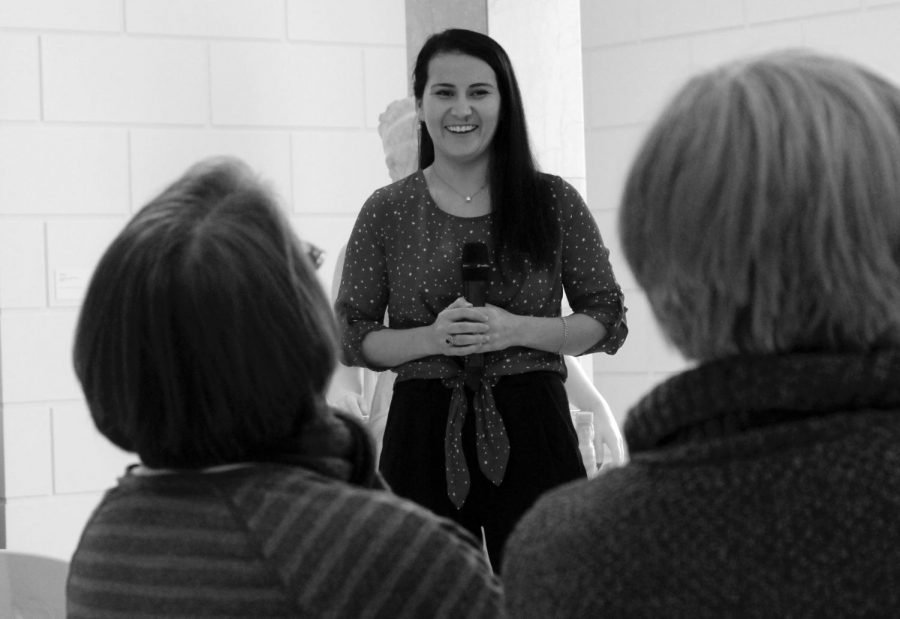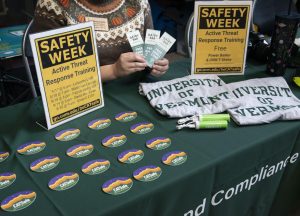Rep. Wazir educates on Afghanistan War
Safiya Wazir, a Democratic member of the New Hampshire House of Representatives, gives a presentation in Fleming Museum, Feb. 28. Wazir was the first refugee elected to the New Hampshire House.
March 6, 2020
At first glance, the rugs displayed on Fleming Museum’s walls appear to be abstract mosaics composed of deep brown and burgundy thread.
Upon closer examination, they depict jarring images of war.
Rep. Safiya Wazir spoke at noon Feb. 28 at Fleming about one of the museums new exhibits, “WARP: War Rugs of Afghanistan.”
The incorporation of politicized images such as AK-47s, fighter jets, tanks and architectural landmarks in artwork began in 1979, after the Soviet Union invasion of Afghanistan, according to Fleming’s website.
As Wazir flipped through a PowerPoint, she told anecdotes about her life as a refugee and her journey to the U.S.
At age six, she fled the war in Afghanistan with her mother and father.
Wazir became a U.S. citizen in 2013.
Now at 29-years-old, she is the first refugee to be elected to the House of Representatives in New Hampshire.
She was elected in 2018 and said she plans to run again.
Wazir said rugs are traditionally made by women who want to make a political statement, yet have not been formally educated.
“[War] destroyed their imagination,” Wazir said. “Women who have zero written language create these rugs from the bottom of their heart.”
Wazir said seeing how vulnerable her six-year-old daughter reminds her of how terrified she was when, at the same age, her community was taken over by the Taliban.
“I would hear the rockets [as] the fighting continued overnight, so I curled under pillows, anything that covered me,” Wazir said. “All the glass in our house shattered.”
Her family fled to Uzbekistan, where they stayed in temporary housing for 11 years before they were able to come to the U.S.
On the plane ride over New York City’s skyline, Wazir said, “I thought, ‘we are home.’”
She said, because of her experiences, she is now an activist for childcare and education. She is also a mother of three.
“I am grateful for family and friends and constituents who voted for me, to allow a person who suffered, and who was war-torn, to be their representative,” Wazir said. “They listen to me, I listen to them.”
Williston residents Deni Berngne and Nina Tomes attended Wazir’s talk and came to admire the artistic details of the WARP exhibit.
“The 9/11 rugs are very powerful, with the dove and two flags,” Berngne said. “The skill that went into making them is incredible.”
Tomes said examining the subtle details of the rugs made her reflect on the people of Afghanistan who experience war and trauma every day.
“That beautiful robins egg blue [in that rug] is so soft to be in something so brutal,” Tomes said.
Rebecca Fields is a photographer who has worked with Wazir for eight years. She documents the lives of refugees in New Hampshire, including Wazir’s family, and has photographed people from over 55 countries of origin.
“It’s activism through photography,” Fields said. “It’s called social documentary photography. It brings up social issues and raises those concerns.”
Wazir said it is important for refugee families to see their lives in photographs.
She said she is glad her children are able to see images of their family and that it is a sign of acceptance.
Wazir said building community is important to her as a political leader.
“No matter who you are, building leadership among people you are surrounded with is fascinating,” Wazir said.
WARP will be open to the public until May 8.







